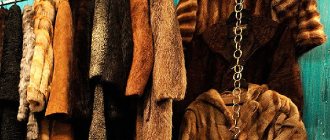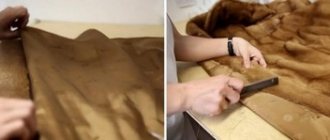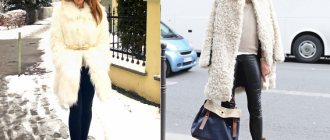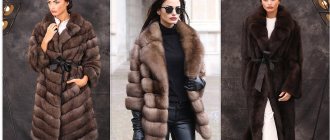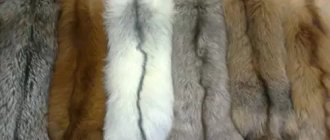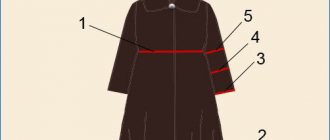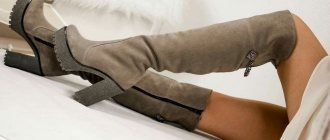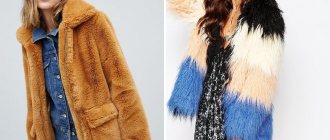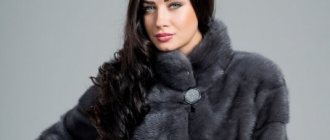At all times, fur coats made from natural furs have been popular. Especially from mink fur. And this is all for good reason: firstly, such products have very high heat-saving properties, which means that even the most severe frost will not matter, secondly, they have a fairly long service life, and thirdly, they have an attractive appearance.
Before making such an expensive purchase and making the right choice, you need to pay attention to the quality of the product and understand some points when choosing.
Types of dyeing of mink coats
As a rule, the most common color that mink skins are dyed is black . If you paint the product correctly, following all the rules and features, then this will not affect the quality in any way. The only thing is that this will affect the price; it will be significantly lower. If this point is not important, then this is the very option that will save money.
Manufacturers who make fur coats are constantly coming up with developments and designs for dyeing mink skins. Experimenting with a variety of colors, dyeing skins in different colors . On the one hand, this is very good, it allows you not to be limited to one color, but on the other, it can mislead the buyer, since there are sellers who can pass off mink as another product.
Types of popular stains:
- The most common methods used to change the color of mink fur products are conventional dipping and tinting . Tinting is used to more or less even out the color of the down and enhance the natural color of the mink. This also helps slow down the appearance of yellow discoloration.
- Tinting with black is necessary when lightening the fur is required.
- Black dyeing - when they try to darken the awn on brown-colored fur to a rich black.
- Strong blue tint - used to enhance the natural color of mink on skins of bluish shades.
- Frost effect is used for painting in two tones.
- Stenciling is when it is necessary to achieve a non-uniform shade, while the design is applied using stencils.
Thanks to the wide variety of types of staining, you can do various experiments.
“Age-related” problems with fur coats
A fur coat is a thing that is bought for many years. And even if the product loses its former appearance over time - it fades under the influence of the sun or loses its former shine - this does not mean that it is time to say goodbye to the thing. You can dye a fur coat and thereby give it a new life.
What problems do fur coats experience during the “aging” process?
- First of all, this is yellowing . Whether light influences this process - artificial or natural - is not important. That is why it is recommended to store a fur coat in a case - otherwise, when opening the closet, light will fall on the fur coat, causing color changes (and often only on part of the product, which makes it much less presentable). It is important to understand that yellowing does not affect different types of fur equally. So for warm shades we can talk about enhancing the color, but white or blue fur coats lose their attractiveness to a greater extent due to yellowing.
- Another problem with fur coats is the aging of the skin itself. This process cannot be stopped, although it does not proceed in the same way for fur coats of different quality. The higher the quality of fur dressing and dyeing of the product, as well as the careful storage, the longer it will retain its strength. But the process practically does not depend on the intensity of operation.
There are two degrees of aging of a fur coat. The first (usually 5-10 years) is characterized by the fact that the fur coat is almost unsuitable for any work associated with humidity and wetness, and the second (above 10 years) is characterized by the dilapidation of the leather base. Often at this moment the fur coat can no longer withstand simple mechanical loads.
Positive characteristics of a dyed fur coat
A natural dyed mink fur coat always looks prestigious. True connoisseurs of processed mink skins always pay attention to the advantages and disadvantages of such products.
The advantages of mink coats include:
- Relatively inexpensive cost . These fur coats are much cheaper than their counterparts, which have a natural color. This allows you to save a significant amount of money.
- Due to the fact that it is possible to use various painting techniques and numerous color schemes, this makes it possible to make various models and options , therefore, allowing you not to be limited to one or two models.
- If high-quality technologies and high-quality materials were used during dyeing of the product, this allows you to extend the service life of this type of outerwear made from mink skins. It can please the owner for 10-15 years .
- The fur of these products is always very soft to the touch and has a beautiful appearance.
- This type of fur perfectly retains its thermal properties , which makes it possible to wear such fur coats even in the most severe frosts.
- Mink can be safely worn even in snowy and rainy weather.
As you can already see, a fur coat made from dyed mink has very significant advantages and benefits.
dyed mink how to wear
In those days when skins played the role of money, mink was never one of them. The gray-brown skins of small European mink, rather inconspicuous in appearance, were not valued as highly as sable, marten and squirrel. Later, when furs remained only an exclusive material for clothing, attention began to be paid to mink as an alternative to expensive sable and marten. At the end of the 19th century, the larger and more beautiful American mink was brought to European territory, which in the 20s of the 20th century formed the basis of the entire fur-bearing animal breeding industry. Today, the world market for farmed mink is about 50 million skins. Mink farming is a significant sector of the economy of such highly developed countries as Denmark and Finland. And the term “fur coat” in 9 out of 10 cases means a product made from mink. A mink coat is no longer protection from the cold or a family heirloom. This is the first rule of playing like a wealthy respectable woman, a classic of the fashion genre.
“Mink”, like “car”, is a very generalized concept. The difference between two mink coats can be no less than the difference between a red Ferrari and a black Volga. To use automotive terminology, a mink coat has a “power density”, i.e. in our case, the type is mink. Although all farmed mink are based on the same American species, depending on the place of breeding and diet, mink fur from different places has completely different properties, which make it possible to conditionally divide the entire mink market into several types.
Types of mink
Russian mink has high guard hair and thick, high underfur, resulting in a very warm, but somewhat shaggy product. The Scandinavian mink is the most widespread on the planet. Its quantity accounts for 80% of the world market for farmed mink. The main features are an even awn of medium height and dense underfur. Within the group, both higher fur (Finnish selection, marked SAGA FURS®) and low fur (Danish selection, marked KOPENHAGEN FURS®) can be found. There is a very rare variety of Finnish mink - the so-called. "polar" mink. This is a brown mink with a pronounced ridge, with very high underfur and a very high awn, which in appearance is more reminiscent of a sable. North American mink is a low-pile mink with a natural velvet effect, since the low, silky spine is almost hidden in the dense, thick and high underfur. There is a so-called “super-short hair”, when the guard hair is below the underfur and the mink has a plucked appearance. High quality and small quantity on the world market have provided this mink with an exclusive place and a high price niche. North American mink can be of two quality systems: American (AMERICAN LEGEND® MINK brand) and Canadian (NAFA® MINK brand). The best black mink in both cases has its own name: the American one is BLACKGLAMA®, and the Canadian one is BLACK NAFA®.
With the growing popularity of low-pile mink, Scandinavian selection is also striving to reduce the height of the pile, and such mink is becoming more and more common in both Finland and Denmark. The “velvet” type (“velvet”, i.e. translated into Russian as “velvet”) is a low-pile (North American-like) variety, separated into a separate sort at Scandinavian auctions. This is not the quality of the pile (within this variety there are any - rare and thick and defective skins), but the appearance. This mink is sold in a separate catalogue, i.e. essentially like another mink. While the quantity of the opposite - long nap mink - is decreasing, within the normal range there are several lots of it, and it is sold as part of the regular catalogue.
In recent years, mink production has increased significantly in China. According to some sources, the number may be about 15 million skins. Since a lot of different gene pools were imported, farms are scattered across different climatic zones, there is no professional training, and not enough time has passed since the start of work, it is impossible to talk about the existence of a separate type of Chinese mink. China raises mink of all types: Russian, Scandinavian and North American. The cheapest Chinese mink is similar to the Russian one of southern breeding - high, hard, lying spine and very weak underfur. The main volume is made up of dark brown (the easiest to breed) and black mink.
Mink colors
The American mink is an ideal object for selective transformations, because... in its genes it carries a huge number of mutations responsible for fur color. The natural palette of raised mink is very large: from white to black, through all brown and gray-blue tones. The most common mink color is brown. Its shades make up more than half of the color variations of mink. Natural black mink (the Finnish name is “scanblack”, the prefix “scan” is currently exclusively owned by SAGA), like all natural black fur, is in fact only very dark brown. This is noticeable when comparing it with dyed black furs, leather and fabric. Dark brown mink is the Russian STK (“standard dark brown”), and the Scandinavian and American “mahogany” is a symbol of the classic mink coat. Variations of the so-called “wild type” repeat the original natural color - brown with a dark ridge. This color has the most official and “folk” names: “wild”, “demi-buff”, “walnut”, “dark pastel”. The light tones of wild type Scandinavian mink are called “(scan)glow”, the dark ones are called “(scan)brown”. The light gray-brown color is called “pastel”. "Lavender" has a light lilac tint and a light undergrowth.
The next group is gray-blue colors. The undisputed leader of this group is the blue mink “sapphire” and its rare light mutation “violet”. This group includes the well-known “silverblue” and the less common gray mink “blue iris”.
White mink is a rare guest on Russian streets. Much more often you can find darker shades - light beige “pearl” and gray-beige “topaz” (“palomino”).
There are now a large number of different color mutations on the market. The most common of them is the “black cross” mink, in which the black fur of the ridge forms a bright cross on the white skin in the “shoulder” area. The rare variations of the cross are very beautiful - blue (“sapphire cross”) and pastel (“pastel cross”). Crosses are bred in small quantities on the basis of all primary colors. The color of the "jaguar" is reminiscent of the traditional cow - white with black spots.
There are extremely rare mutations of mink, whose worldwide number can be limited to hundreds of skins, for example: gray mink with tiny white inclusions - “stardust”, “cinnamon”, reminiscent of beige milk foam with brown specks on cappuccino cup or marble (“marble”) mink – dark yellow with chocolate stains.
Mink fur processing technologies
Despite the variety of natural colors, mink fur is successfully dyed in various colors. In addition to traditional immersion dyeing and tinting, there are many “complex” multi-layer dyeing: light colors are dyed while reserving the top of the guard hair, obtaining the so-called. “snow tops” - “snow-top” (snowtop), wild-type mink is bleached to a “golden” color. Enhancing the color of natural ridges is often used. A hit of the late 90s was stencil (surface) dyeing of mink to look like “leopard”, “tiger”, etc. The latest development of technologists - “digital” (“digital”) dyeing (the process is computer controlled) allows you to apply any multi-colored patterns to the fur.
Designers are always trying to change the very texture of mink fur. The most common types of fur processing are plucking and shearing. When pinched, the guard hair is removed, leaving a velvety underfur. When shearing, the spine is shortened, but if you run your hand over the skin, especially against the grain, you will feel a tingling sensation. Most often, a combination of plucking + cutting technologies is used. After removing the guard hair, the “velvet” is trimmed to the desired height, or “corduroy” is made from the “velvet” (multi-level cutting technology - “grooving”).
Recently, “high” technologies for processing mink have become widespread - laser cutting (or rather, burning), in which patterns of hair of different heights are applied to the fur, cutting perforation (“lace”), notch perforation. Particularly popular is the processing of the hide into leather and suede for fashionable mink sheepskin coats.
The triumph of technological processing came at the beginning of the millennium. Using a combination of all technologies, a material completely different from fur was obtained from mink. For example, they took two-layer dyed plucked skin and processed it using the “grooving” technology, and as a result they obtained corduroy with different colors according to the depth of the “scars”. Bleaching is very popular: “golden” mink of all shades from cognac to biscuit and the contrast of light underfur (color options from milky to light yellow) with dark hair. At the moment, the most popular option is silver-blue mink with lightened underfur; this color is called “crushed ice” or fume.
Modern dressing technologies have also made it possible to level out the “historical” difference in products made from male and female mink. But even now we have to admit: a product made from males is heavier than a similar product made from females. But you should definitely add: weight is added not so much due to the thickness of the flesh, but due to the number and length of hair.
Technologies for sewing mink fur products
If we return to manufacturing options, then a mink product can be sewn from whole skins or “unraveled.” When unraveled, the skin is cut along the ridge into two parts and “herringbone” at a certain angle into strips 2-3 mm wide, the strips are shifted and stitched. The result is a strip about 1 m long and 5-7 cm wide. When sewing “unfolded,” the modeling possibilities expand; the fur product has no visible joints between the skins and looks “monolithic.” The disadvantages of this technology include some weighting of the product and a huge number of seams that completely hide the quality of the original skin. The generally recognized leaders of the dissolution are manufacturers from China and Greece. They produce 95% of all dissolved products. There is a so-called “figured dissolution”, in which a strip of any shape is sewn from trapezoidal skin. Typically, details made using the figured dissolution technology are elements of product decoration.
Separately, fur knitwear is gaining more and more popularity. This technology, created by Canadian designer Paola Lishman initially for beaver, is, in fact, not “knitting”, but weaving on a special elastic base mesh. Now fur knitwear from mink and other expensive furs is in the collections of the world's best companies.
One of the advantages of mink fur is its amazing practicality. With proper storage and careful handling, a mink coat can last 20-30 years. In terms of wear resistance, mink is equal to sable and is 70% of the standard - otter.
The popularity of mink products is increasing from year to year. Despite the fact that it is the most versatile and widespread of furs, mink never gets boring. Its possibilities for changing textures and colors are truly limitless; its natural beauty has captivated fashion designers. Recent seasons have shown a high interest among fashion trendsetters in the natural palette and natural texture of mink. Today, white, black, brown and blue mink triumphantly walk down the catwalks of Paris, Milan, London, Madrid and New York, deservedly taking their place among the most modern and exclusive materials in the fashion industry.
Source: https://mexaimoda.ru/ru/read/interesting/furs/mink.html
Disadvantages of this type of outerwear
Like any other thing, coats made from dyed skins have disadvantages that you should pay attention to when purchasing.
The disadvantages of mink products include:
- High price . Even though a dyed product is cheaper than a natural one, it still remains expensive, since not everyone has the opportunity to purchase it.
- Expensive repairs . If repairs are still required, it will not be cheap precisely because the fur coat itself is not cheap.
- Items made from natural fur require special care ; they must be constantly aired, protected from moths, and stored exclusively in a case.
- There is a high probability of running into a fake , since products that undergo various processing are the easiest to counterfeit.
In order not to run into a fur coat that will only disappoint you in the future, you need to buy them only from trusted sellers and suppliers.
How to distinguish dyed mink from undyed mink: methods, description
First of all, carefully examine the flesh (skin tissue).
- Fur that has undergone a dyeing procedure has a dark inner core. Colors: from black to gray.
- In fur that has undergone a tinting procedure, the core can vary from gray to a natural light beige tone.
- The flesh of undyed fur is light beige or beige (regardless of the color of the fur).
Pay attention to the color of the fur.
- Most often the fur is dyed black. Be careful: natural black mink fur has a brownish-gray tint. This is especially noticeable in natural light.
- The color of dyed fur in any light is deep anthracite, without a natural transition in color intensity, without shades between the guard hair and the down.
Important: modern technologies make it possible to dye the fur with subsequent lightening of the underbelly. The bleaching process significantly degrades the quality of the fur! Unfortunately, the average buyer will not be able to distinguish such fur from the real thing. The only way out is to look at the product certificate.
The process of dyeing natural fur with hair dye
Before dyeing, a fur skin or a fur cap for a hat, which you have cut out and sewn from whole skins or worn fur (an old hat or collar), must be degreased by washing, since oily and dirty hair does not dye well. Unpainted areas and stains appear.
Prepare water at room temperature in a cup, add washing powder in a small amount and wash gently. The skins should already be tested for water, as sometimes the skins swell and tear from water. To prevent the skins from tearing, wash them without sudden movements and try not to twist them when squeezing. After washing, the skin is rinsed in clean warm water, lightly wrung out and prepared for painting.
How to dry fur properly
To dry dyed fur, you need to use a hair dryer; it is best and more effective to use an old-style vacuum cleaner with reverse draft. Under the influence of an air stream, the fur quickly dries and fluffs up. If these are new skins and not cut along the belly, they can be pulled over the rules with the fur outward and dried. The cut ones are stretched with nails on the shield with the fur facing out, after drying they are removed and crumpled. Such dyed skins can later be used to sew new hats or repair fur coats. Finished sewn and dyed fur caps for hats made by molding are dried with an air stream and, half-baked, pulled onto the block.
When repairing mink coats, it is sometimes necessary to tint the brown fur directly on the coats. The paint is rubbed with a swab into the faded area, after painting it is quickly washed off with water and dried with an air stream.
Restoration of products after dyeing
| Size | In Malakhovka |
| Vest | 10,000 rub. |
| Jacket (length up to 65 cm) | from 15,000 to 18,000 rub. |
| Short fur coat (length up to 90 cm) | from 18,000 to 20,000 rub. |
| Short fur coat (up to 105 cm) | from 20,000 to 23,000 rub. |
| Long fur coat (from 110 cm) | 25,000 rub. |
| Cover with new lining | 25,000 rub. |
| Flare (depending on the length of the product) | from 10 – 30% |
| Hood | 2,000 rub. |
Prices do not include the cost of the stock (up to size 50)
Spray for coloring fur
Often finished fur products (hats, fur coats) look excellent when worn for a long time, but faded spots appear in some places. In this case, there is no need to paint the entire thing; it is enough to touch up the problem areas with a spray.
To dye fur, you can use aerosol paint for caring for suede. It consists of metal cans of spray paint.
Aerosol for suede care
You need to choose the right shade correctly, otherwise the dyed fur will differ sharply from the main one. The area that needs to be tinted is cleaned of dirt and can be degreased with alcohol and wiped with a swab. It is advisable to cover the fur with any material, except for tinted spots. We spray the paint at a distance of 30 -40 cm so that the fur does not stick together and a uniform color is obtained. In this way you can get an excellent result, the painted areas will not differ much from natural fur, the paint will last for several months.
Preparing the product for painting
Fur skins, individual pieces or a finished sewn fur cap for a hat need to be prepared for painting. Fur pelts must first be tested for exposure to water. Fur, before dyeing, must be degreased and cleaned of dirt by washing. Then it is thoroughly washed in water, dyed, washed and washed again. Skins, due to long-term storage or wear, new skins due to improper dressing may lose their strength and, when exposed to water, swell and tear. That's why all skins need to be tested for water before painting. Separate pieces or thin places of the skin are soaked or thrown into a bowl with warm water and observed for 10 - 15 minutes; if nothing happens to the skins, they remain strong, such skins can be dyed. It happens the other way around: the skins swell, tear when stretched a little, and even worse, become limp, like blotting paper. Such skins must be discarded, otherwise big problems will arise.
Before painting, defects on the skins are eliminated: bald spots, worn out and moth-eaten areas, bites and tears. These places are cut out in the shape of a fish, inserts are sewn in, or simply cut out and stitched. Weak skins, especially at the seams, are strengthened by gluing strips of spunbond non-woven material or non-woven material with MOMENT 1 glue. MOMENT 1 glue is ideal for skins.
Selection of shades for different fur colors
You need to dye the fur in a tone that will be an order of magnitude darker than the existing one. For example, if you need to dye brown mink fur, be sure to use a darker dye. FARA paint – dark brown No. 502 is suitable for natural brown mink. Mink fur, like any other, is dyed differently. New fur that has not been exposed to sunlight (new skins) dyes very poorly; you have to increase the concentration of dye by adding a darker one.
So, for example: you can add half a tube of black paint No. 501 to dark brown paint FARA No. 502. You can increase the concentration even more by adding half a tube of dark brown paint No. 502 to a tube of black No. 501.
New mink or muskrat fur does not dye well, so often after drying it has to be re-dyed in the same way to achieve dark shades. Old (worn) fur of mink, muskrat and other animals, which has been exposed to sunlight, dyes much better and the longer the fur is worn, the more intense the color. Within 30 minutes to an hour, the skin is completely painted with dark brown FARA dye No. 502 or No. 501.
Painting of fur products
| Name (painted black, brown, graphite) | Price in Malakhovka |
| Skins: | |
| Beaver (not shorn) | 95 rub. dm 2 |
| Beaver (shorn) | 65 rub. dm 2 |
| Long fur (fox, arctic fox, etc.) | 580 rub. dm 2 |
| Short fur (marten, mink, sable, polecat, etc.) | 525 rub. dm 2 |
| Plates (astrakhan fur, mink) | 65 rub. dm 2 |
| Products: | |
| Vest | 7,000 rub. |
| Jacket (length up to 65 cm) | 8,000 rub. |
| Short fur coat (length up to 90 cm) without hood, excluding restoration | 12,000 rub. |
| Short fur coat (length up to 105 cm) without hood, excluding restoration | 16,000 rub. |
| Flared (for vests, jackets and short fur coats) | + from 10 – 30% to the price for dyeing depending on the length of the product |
| Straight fur coat (length from 110 cm) without hood, excluding restoration | 18,000 rub. |
| Flared fur coat (length from 110cm) excluding restoration | 23,500 rub. |
| Hood, excluding restoration | 3,000 rub. |
| Collars, cuffs, trims (long fur) excluding restoration | 95 rub. dm 2 |
| Collars, cuffs, trims (short fur) excluding restoration | 65 rub. dm 2 |
| Hats, excluding restoration | 1,300 rub. |
DO NOT DYE SHEEPSKIN COATS, SHEEPSKIN (NOT SHEARED) AND LEATHER!
- Painting time 2 weeks
- Shrinkage of a fur product when painting is 30% (1 size)
- Shrinkage during dyeing always occurs and the product shrinks unevenly
- It is necessary to restore (restore) the product after dyeing !
Other dyeing methods
Fur can be dyed in many ways. For these purposes, there are oxidative, direct, active, acidic and a whole range of dyes, including natural preparations. When painting, the dipping method is mainly used and, less often, the spreading method. All these methods are labor-intensive and require, in addition to the use of basic dyes, a whole range of additional preparations.
Aerosol paint spraying
When dyeing fur at home, it takes all daylight hours. A finished fur product (hat, fur coat, vest) cannot be dyed using the dipping method; it is necessary to separate the fur skin from the lining material, and during painting the skins may shrink, and the skins decrease in size when drying. You can tint some defective areas (worn or faded), for example, on a fur coat or hat, by rubbing the paint into the fur using a spread method, and then quickly rinse with water and dry. With this method, household cream hair dyes have proven themselves to be excellent. Sometimes such problem areas are tinted with aerosols by spraying paint.
Why is there a need to change the color of the product?
Now many women turn to specialists with a request to dye their mink coat or sheepskin coat. The main reason is the loss of the original color of the product, fading, and deterioration of the fur in general. This in turn arises due to:
- Old things - the fading of fur over time is familiar to everyone.
- Improper storage conditions, as a result of which the item loses its attractiveness and strength.
- Unsuccessful dyeing in the past - often owners of fur coats try to dye the fur themselves or turn to unqualified specialists.
Either way, a problem arises and something needs to be done.
Caring for dyed fur
As a result of painting fur skins, individual pieces, fur caps for hats with persistent household cream hair dyes, carried out using the spread method, by rubbing the paint into the fur, we obtain a stable color. The paint is resistant to light, water and mechanical stress when wearing fur for a long time. Such items do not require special care; the requirements are the same as for any fur product.
The requirements for fur dyed by spraying are completely different. The color is not particularly durable, so it is better to protect such a product from the influence of light, water, mechanical stress and elevated temperature.
In order for the dye to stick better and the fur to shine, it can be treated with a special balm for the care of dyed hair. After this treatment, the fur becomes softer and fluffier.
Fur products require daily care, combing more often, and require thorough cleaning. Much depends on proper storage. Fur should be covered and stored in a dark place.
